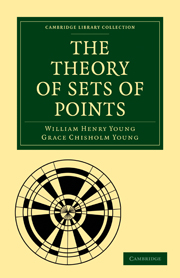Book contents
- Frontmatter
- PREFACE
- Contents
- CHAPTER I RATIONAL AND IRRATIONAL NUMBERS
- CHAPTER II REPRESENTATION OF NUMBERS ON THE STRAIGHT LINE
- CHAPTER III THE DESCRIPTIVE THEORY OF LINEAR SETS OF POINTS
- CHAPTER IV POTENCY, AND THE GENERALISED IDEA OF A CARDINAL NUMBER
- CHAPTER V CONTENT
- CHAPTER VI ORDER
- CHAPTER VII CANTOR'S NUMBERS
- CHAPTER VIII PRELIMINARY NOTIONS OF PLANE SETS
- CHAPTER IX REGIONS AND SETS OF REGIONS
- CHAPTER X CURVES
- CHAPTER XI POTENCY OF PLANE SETS
- CHAPTER XII PLANE CONTENT AND AREA
- CHAPTER XIII LENGTH AND LINEAR CONTENT
- APPENDIX
- BIBLIOGRAPHY
- INDEX OF PROPER NAMES
- GENERAL INDEX
CHAPTER VII - CANTOR'S NUMBERS
Published online by Cambridge University Press: 07 September 2010
- Frontmatter
- PREFACE
- Contents
- CHAPTER I RATIONAL AND IRRATIONAL NUMBERS
- CHAPTER II REPRESENTATION OF NUMBERS ON THE STRAIGHT LINE
- CHAPTER III THE DESCRIPTIVE THEORY OF LINEAR SETS OF POINTS
- CHAPTER IV POTENCY, AND THE GENERALISED IDEA OF A CARDINAL NUMBER
- CHAPTER V CONTENT
- CHAPTER VI ORDER
- CHAPTER VII CANTOR'S NUMBERS
- CHAPTER VIII PRELIMINARY NOTIONS OF PLANE SETS
- CHAPTER IX REGIONS AND SETS OF REGIONS
- CHAPTER X CURVES
- CHAPTER XI POTENCY OF PLANE SETS
- CHAPTER XII PLANE CONTENT AND AREA
- CHAPTER XIII LENGTH AND LINEAR CONTENT
- APPENDIX
- BIBLIOGRAPHY
- INDEX OF PROPER NAMES
- GENERAL INDEX
Summary
Cardinal numbers. In Ch. IV we discussed the various potencies which could occur on the straight line, and found that, as far as the present state of knowledge extends, these may be characterised by the positive integers, together with two new symbols, for which we took the letters a and c, a denoting the potency of a countably infinite set, and c that of the continuum.
In the preceding chapter we have seen that there is a fundamental region F, in which there is a potency ℵ1 which is different from any of those mentioned, unless it is possibly the same as c; this latter point has not yet been settled.
These are particular cases of a great theory of potencies and of cardinal numbers in general, due to Cantor, and which has occupied numbers of mathematicians ever since: the theory, at first apparently simple, is by no means in a satisfactory state, and it will only be possible in this chapter to give a short account of it, avoiding controversial points, and giving references as to the literature.
The word set has come to be used in general for what Cantor called a well-defined set. The following is the definition originally given by Cantor:—
“Ein Inbegriff von Elementen, die irgend welcher Begriffssphäre angehören, nenne ich wohldefinirt, wenn auf Grund ihrer Definition, und in Folge des logischen Princips des ausgeschlossenen Dritten es als intern bestimmt angesehen werden muss, sowohl ob irgend ein derselben Begriffssphäre angehöriges Object zu dergedachten Mannichfaltigkeit als Element gehört oder nicht, wie auch ob zwei zur Menge gehorige Objecte, trotz formaler Unterschiede in der Art des Gegebenseins einander gleich sind oder nicht.”
- Type
- Chapter
- Information
- The Theory of Sets of Points , pp. 145 - 160Publisher: Cambridge University PressPrint publication year: 2009First published in: 1906

